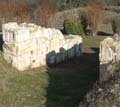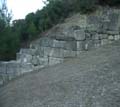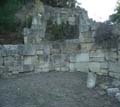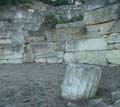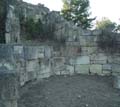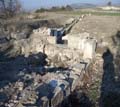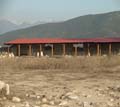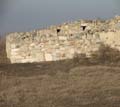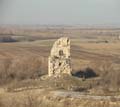
In the area of the city of historical times remains from the late Neolithic and the Bronze Age (5th - 2nd millennium BC). It was founded near the river Strymonas by the Athenians in 437 BC. with the participation of Ionian colonists. The Thracian polity of Nine Roads existed in the area. There was a prosperous commercial center on Egnatia Odos. In 168 BC became the capital of the first Roman portion of Macedonia. The imposing fortifications of the city are preserved in very good condition and date from the classical to the early Hellenistic years. It consists of two monumental precincts. Gates, towers, bastions, stairs and sewers are still preserved, as well as the wooden piles of a bridge, a unique and impressive find. The city's gymnasium (3rd - 1st century BC), small sanctuaries of Attidos and Cybele were also discovered. Thesmophorium for the cult of Demetrius and Koris (5th century BC) and sanctuary of Muse Kleios (4th century BC). A few houses and a network of paved streets have been identified from the urban fabric. Rich cemeteries and three Macedonian tombs testify to the prosperity of the city from the end of the 5th century BC until the 1st century BC. Outside the city dominates the Kasta burial mound. Amphipolis was destroyed in the middle of the 1st century BC. from Thracian races. On the west bank of the Strymons is erected "the Leo of Amphipolis", the imposing "sign" of a funerary or memorial monument (last quarter of the 4th century BC) in honor of a famous Amphipolitan. Rich cemeteries and three Macedonian tombs testify to the prosperity of the city from the end of the 5th century BC until the 1st century BC. Outside the city dominates the Kasta burial mound. Amphipolis was destroyed in the middle of the 1st century BC. from Thracian races. On the west bank of the Strymons is erected "the Leo of Amphipolis", the imposing "sign" of a funerary or memorial monument (last quarter of the 4th century BC) in honor of a famous Amphipolitan. Rich cemeteries and three Macedonian tombs testify to the prosperity of the city from the end of the 5th century BC until the 1st century BC. Outside the city dominates the Kasta burial mound. Amphipolis was destroyed in the middle of the 1st century BC. from Thracian races. On the west bank of the Strymons is erected "the Leo of Amphipolis", the imposing "sign" of a funerary or memorial monument (last quarter of the 4th century BC) in honor of a famous Amphipolitan.
The city was an important political and ecclesiastical center from the middle of the 5th to the middle of the 6th century. A.D. It declines in the 7th century. Four large early Christian basilicas (mid 5th - mid 6th century), a large rectangular building (bishop) with an integrated circular building, perhaps a tank, and an imposing pericentric temple with a hexagonal core have come to light. The walls of the basilicas were decorated, in their lower parts, with orthomarbling and, in the higher parts, with mosaics. Mosaic floors from Basilica A, a marble ceiling, fragments of mosaics from the surrounding temple and a number of marble architectural members and sculptures have been preserved. Samples from the production of the local plastic, ceramic,
Editor: Fotini Anastasopoulou










